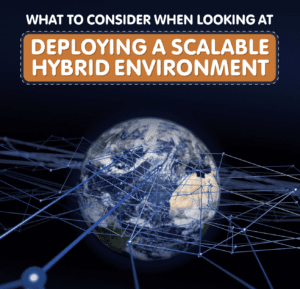
The benefits of hybrid cloud infrastructure are evident, and it’s a key component of your digital transformation (DX) objectives. But the cloud isn’t just a destination. It’s an operational model and part of your overall architecture solution. Unlike stitching together a patchwork of cloud services, developing a strategy early on ensures business continuity.
Therefore, your success depends on a well-crafted plan that aligns with your goals. Use this cloud implementation checklist to start a conversation in your organization and move your company towards a scalable hybrid environment.
Planning and Preparation: Cloud Implementation Checklist
A mix of on-premises IT, private cloud, and public cloud infrastructure gives organizations the best of all worlds. Indeed, more than 91% of International Data Corporation (IDC) survey respondents “rated modernized infrastructure as a critical determinant of their DX,” and 70% will refresh servers, storage, or data protection over the next two years.
An operational roadmap ensures consistent experiences. IDC recommends planning for three deployment models, building relationships with Managed Cloud Service Providers (MCSPs) early, and developing a clear strategy.
Use this checklist as you explore hybrid environments:
- Conduct a cloud readiness assessment
- Select the right cloud deployment model
- Define success and how it’s measured
- Decrease unexpected IT costs
- Address staffing challenges early
- Overcome security and privacy challenges
- Reduce complexity at each step
1. Conduct a Cloud Readiness Assessment
Complete an evaluation to uncover opportunities and risks associated with cloud deployment. An assessment provides data for your strategy and goal measurement. This visibility improves decisions about which workloads, applications, and data to keep in your on-premise infrastructure, what can be moved to the cloud, and which ones to eliminate.
Examine your in-house IT team capabilities, security requirements, and operational readiness. Then take a comprehensive look at your existing IT infrastructure. Work with your MCSP to analyze current capabilities and ensure a solid foundation for your hybrid cloud environment.
Gather information about:
- Applications and their purpose
- The number of users and usage volume
- Costs associated with network, hardware, and storage
- The consumption level of various resources
- Current ease of application modification
- Dependencies between applications, networks, and data
- Type of technologies in use, from database servers to IT management tools
- Applications’ integration limitations and capabilities
2. Select the Right Cloud Deployment Model
Your cloud deployment should satisfy security, performance, integration, and legal requirements. To this end, optimal workload placement in the cloud is essential. It should account for ease of management, usage patterns, cost, and data gravity. Also, consider future IoT deployments and the role of edge computing.
McKinsey reports that “about 75% of large companies route all cloud traffic through their data center.” This method can add significant latency and increase hosting costs by 10% to 20%. Consequently, “fewer than 20% of CISOs expect to use this option in the future.”
Likewise, IDC estimates “more than 30% of all categories of enterprise workloads and most workloads will be deployed on cloud-based infrastructure by 2024.” An effective IT modernization strategy allows companies to meet future needs, such as changing workload characteristics while controlling costs.
3. Define Success and How It’s Measured
Many leaders want to maximize efficiency, meet service-level agreements (SLAs), and enhance security at the lowest cost. Broader business rationale involves improving resiliency and achieving scalability. Of course, the main purpose is to deliver a consistent cloud experience across all deployment models.
Making goals is one thing. But measuring them can be much more challenging. Indeed, IT leaders say an unclear or uncertain return on investment (ROI) is a primary barrier to cloud adoption. Fortunately, your technology partnerships can help with both areas, from aligning your strategy to organizational goals to unifying data on a central dashboard.
4. Decrease Unexpected IT Costs
Understanding where your current capabilities fall short helps you address problems early and reduce surprise expenses. According to IDC, “mismatched expectations on the total cost of ownership (TCO)” are obstacles to adopting hybrid cloud platforms.
For example, suppose you’ve already transferred large data sets to public clouds and decide to download it to a private or on-premise model later. In that case, you may pay additional money for this burst scenario. In addition, unexpected upgrades to your current infrastructure impact your budget. It’s vital to assess your network design and bandwidth to ensure you can efficiently connect multi-tier applications.
5. Address Staffing Challenges Early
McKinsey finds that 87% of leaders “are aware that they either already have a skills gap, or will have one within a few years.” Skillset limitations directly impact your cloud deployment, affecting budgets, timelines, and business continuity. A successful plan calls for upskilling employees and providing resources to navigate the hybrid cloud environments. Understand constraints and develop a strategy that includes hiring skilled workers, retraining your current workforce, and outsourcing tasks to an MCSP.
6. Overcome Security and Privacy Challenges
Your organization must agree on data governance and security priorities while defining role-based rules for data access, sharing, and ownership. Use plain language to define policies and strive to eliminate the problem of ad hoc security by taking a proactive approach instead of a reactive one.
Coordinate your initial security assessment with your MCSP to ensure your hybrid environment meets standards and considers your business needs, such as:
- Virtual private networks (VPNs)
- Data encryption in motion and at rest
- Unified security monitoring for multiple clouds
- Regulatory requirements
7. Reduce Complexity
There are many moving parts in an enterprise-wide cloud deployment. And one missing piece can snowball into a crisis affecting customers and employees. But it’s harder to monitor and seamlessly roll out cloud services when working with multiple vendors. Consequently, tracking SLAs and agreements can quickly turn into a full-time job.
On the other hand, technology partnerships and single-vendor solutions decrease complexity before, during, and after your cloud deployment. An MCSP provides pre-project support by strategizing and defining clear goals. They perform the cloud implementation on time and budget while facilitating the setup with minimal to zero disruption to your business. Moreover, an MCSP delivers ongoing support services after deployment.
Avoid Missteps by Developing a Strategic Focus
A comprehensive strategy serves as a roadmap for leaders scrambling to build scalable hybrid environments. While successful cloud deployment requires a lot of prep work, your technology partnerships can optimize your resources and support your organization. Start your cloud journey by selecting a cloud services provider offering infrastructure services, consistent performance, and security features.
- How SD-WAN Can Help Your Business Tackle Evolving Network Challenges - December 5, 2022
- What to Consider When Exploring Implementation of a Scalable Hybrid Cloud Environment - September 28, 2022
- How to Securely Extend Your Enterprise to Anywhere Employees Work - September 13, 2022


